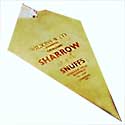Snuff: what it is and how it was used in the past

Snuff is a fine powder made from tobacco, containing nicotine with various other chemicals. This page explains why and how it was used in the past, whether it was harmful, how it was sold and how it was kept airtight in snuff boxes, both at home and on the person to be carried around. Highlights are the personal recollections.
____
By the webmaster based on discussions with older people and research in museums
I did read about people taking snuff and although I saw it in period films, I never saw anyone using it is real life. I suppose it was going out of fashion by the time I was born in 1939, and perhaps the austerity during the Second World War had something to do with it - or maybe it was a private activity, normally among older men.
How and why snuff was used
I used to hear people talk about 'a pinch of snuff'. I understood that pinching it lifted a tiny amount.
Traditionally the pinch of snuff would have been placed on the back of the hand or held pinched between the thumb and index finger. The action of sniffing the powder caused the nasal passages to get a coating of tobacco from which the user would get a quick 'hit' from the nicotine. Afterwards, the user would use a large handkerchief to blow his nose, so clearing his nasal passages. I used to hear that the handkerchief would end up mucky and quite revolting. In fact, in my childhood, sniffing snuff was widely regarded as a filthy habit.
Whether or not sniffing the snuff gave the same extended feelings of relaxation as cigarettes, I don't know.
Was snuff harmful?
Snuff tobacco not only contains nicotine but also other harmful, cancer-causing chemicals. Using it can lead to addiction and can cause cancers of the mouth and other areas. It is also reported to be associated with heart disease and strokes. Much of this, of course, was not known in the past when the use of snuff was common.
How snuff was sold
I did see snuff on sale in tobacconists shops in the 1940s and 50s.
It was either sold in special small tins or and weighed out for each customer and packaged in twirls of paper with the maker's name printed on, like in the photo.

How snuff was sold, photographed in Winchester City Museum
Snuff boxes
I understand that bought snuff was transferred at home into a dedicated relatively air-tight snuff box, so as to keep its aroma. Snuff boxes could be quite elegant and the design and quality of their materials was an accessory that said something about their owners, as did cigarette cases for cigarette smokers. They were often sold as snuff boxes or pill boxes.
The following photo shows snuff box that is curved to fit into a man's breast pocket.

Snuff box, curved to fit into a man's breast pocket
There were also much larger snuff boxes, often silver and intricately embossed, suitable as ornaments to be permanently on display.
There were still a lot of snuff boxes around in the 1940s and 50s. I never questioned what they were. I suspect they had never been used as I don't remember any tobacco smell in them. Like other children, I just used them for keeping trinkets in. I once had the experience of secreting a little of the school chemistry lab's mercury into my box because mercury was so fascinating the way it rolled around and split into little balls. When I got home, I opened my box, but no mercury. Only later did I find out that my box was metal and that mercury dissolved metal.
| sources | webmaster | contact |
Text and images are copyright
If you can add anything to this page or provide a photo, please contact me.



